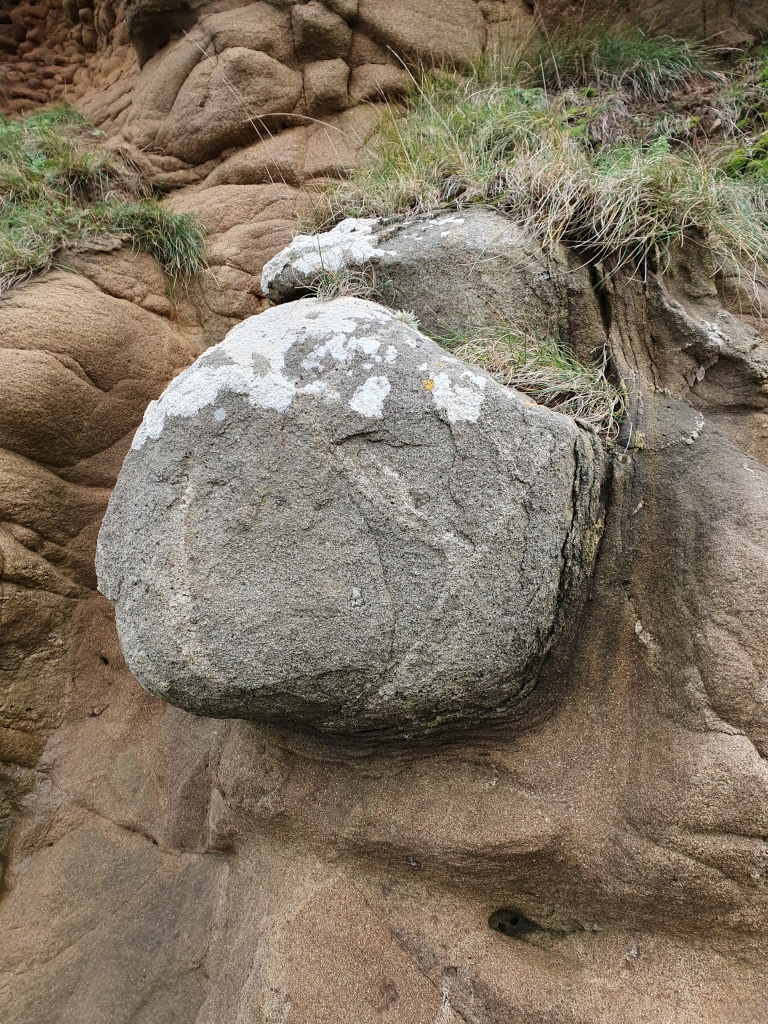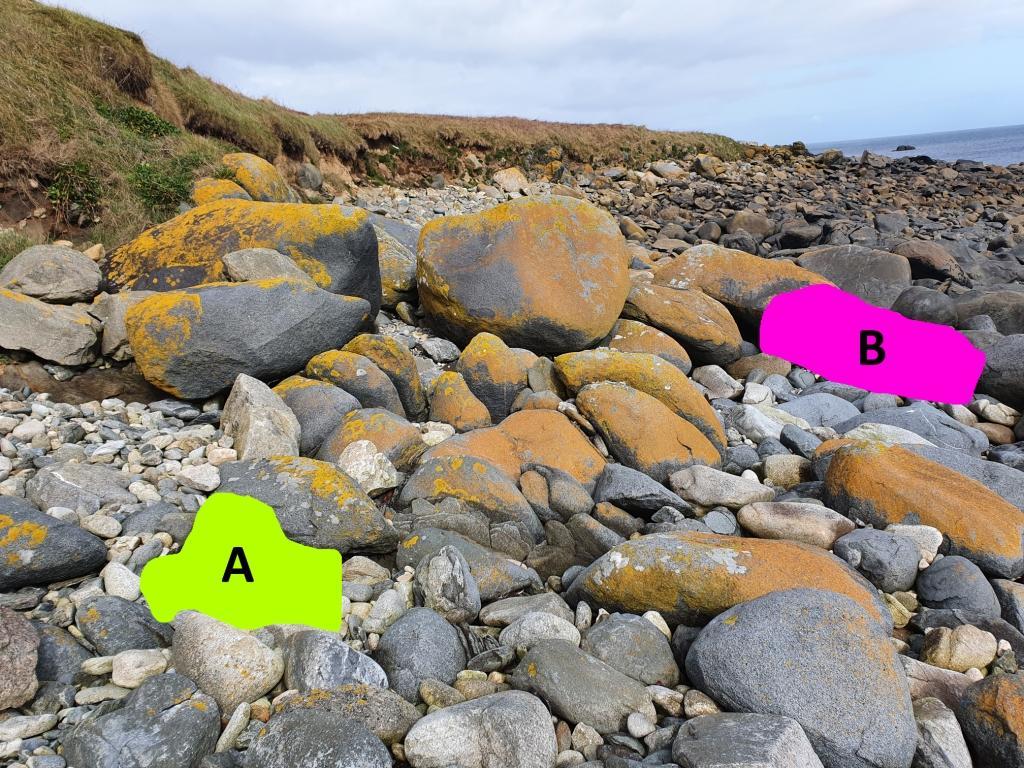Attention, l’Earthcache est accessible à marée basse. Horaires des marées sont ici.
Vous vous engagez de votre propre initiative dans la recherche de cette cache à vos risques et périls. Je décline donc toute responsabilité en cas de problème.
Il s'agit d'une Earthcache, il n'y a pas de récipient à chercher.
Oignons à l’île de Batz
Diorite
Sur la côte nord de l’île et à la pointe ouest, on peut observer l’affleurement d’amas sombres dans l’estran et, plus visibles, de boules, souvent énormes, de teinte bleu-noir, offrant une desquamation en pelure d’oignon caractéristique. Le grain est fin à moyen, la minéralogie montre labrador (plagioclase), biotite et hornblende verte (amphibole).

Le magma dioritique est plus basique que le magma granitique, ce qui se manifeste notamment par une teneur en silice nettement plus faible (57% contre 72% l’île de Batz), par des teneurs en fer et magnésium, en chaux, plus élevées. Sur ces affleurements de l’île de Batz, il est remarquable de pouvoir observer au contact entre granite et diorite des phénomènes de mélanges et d’hybridation entre les deux magmas qui témoignent de la contemporanéité de leur mise en place, il y a 320 millions d’années.

Erosion en pelures d’oignon
Toutes les roches silicatées s'altèrent, et toute roche sans structuration interne (sans schistosité, ni joint de stratification…) peut donner une altération en boule.
Les diorites, bien que très dures, sont sensibles à l’altération météorique qui, à partir des diaclases, tend à les transformer peu à peu, en boules, selon le processus de desquamation « en pelures d’oignon ». Les boules accumulées sur les estrans ne doivent pas leur modelé à la mer mais à l’altération continentale, les eaux marines se bornant à enlever leur écorce et à en polir la surface libérée de son manteau d’altérites : leur dégrossissage est terrestre, leur polissage marin.
A Porz Gwenn les boules et affleurements de diorite sont très nombreux. On y trouve de beaux exemples de débit en pelure d’oignon juste à côté d’une grosse boule de diorite cassée pour une exploitation abandonnée.

Kersantite: exemple de l'érosion en boule
Perrières
A l’île de Batz le granite (épisodiquement aussi la diorite) a fait l’objet d’une exploitation intense comme en témoignent les vestiges des anciennes extractions (appelées « perrières ») tout au long de la côte rocheuse. Pas de grandes carrières mais un grand nombre de perrières partout où la roche à l’affleurement présentait qualité et facilité d’extraction. Le littoral montre encore, ici et là, des gradins successifs aux rebords anguleux, des blocs isolés portant traces de trous pour les coins de tentatives de débitage, les innombrables débris de taille pas encore façonnés par les vagues.

Bloc de granite avec traces de coins de débitage
Sources
Wikipedia
Une roche identitaire, Le Granite de l’île de Batz (Finistère)
https://www.geoportail.gouv.fr/donnees/cartes-geologiques
https://planet-terre.ens-lyon.fr/
Chauris, Louis : Pour une géoarchéologie du patrimoine : pierres, carrières et constructions en Bretagne
Questions pour valider cette Earthcache :
- Identifiez les zones A et B de la Photo 1. Que voyez-vous sous la zone verte A ? Décrivez l'altération de la roche sous la zone verte A. Est-elle artificielle ou naturelle ? A quoi vous fait-elle penser ?
- Que pouvez-vous observer sous la zone rose B ? Décrivez l’altération de la roche. Est-elle artificielle ou naturelle ? A partir de quelles observations pouvez-vous déduire cela ?
- Une photo de vous ou d’un objet vous représentant sur le site.

Loguez cette cache "Found it" et envoyez-moi vos propositions de réponses soit via mon profil, soit via la messagerie geocaching.com (Message Center), et je vous contacterai en cas de problème. Les logs enregistrés sans réponses seront supprimés.
English version
Please note, the Earthcache is accessible at low tide. Tide times are here.
You engage in the search for this cache on your own initiative at your own risk. I therefore decline all responsibility in the event of a problem.
This is an Earthcache, there is no container to look for.
Onions on the island of Batz
Diorite
On the north coast of the island and at the western tip, we can observe the outcrop of dark clusters in the foreshore and, more visible, balls, often huge, blue-black in color, offering a peeling peel. characteristic onion. The grain is fine to medium, the mineralogy shows labrador (plagioclase), biotite and green hornblende (amphibole).
Dioritic magma is more basic than granitic magma, which is manifested in particular by a significantly lower silica content (57% against 72% on the island of Batz), by higher iron and magnesium and lime contents. . On these outcrops of the island of Batz, it is remarkable to be able to observe in contact between granite and diorite phenomena of mixing and hybridization between the two magmas which testify to the contemporaneity of their establishment, there are 320 million years.
Onion peel erosion
All silicate rocks deteriorate, and any rock without internal structuring (without schistosity, nor stratification joint…) can give a ball weathering.
The diorites, although very hard, are sensitive to meteoric weathering which, starting from the joints, tends to transform them little by little, into balls, according to the process of desquamation "in onion peels". The balls accumulated on the foreshore do not owe their model to the sea but to continental weathering, the marine waters being limited to removing their bark and polishing the surface freed from its coat of alterites: their roughening is terrestrial, their marine polishing.
At Porz Gwenn there are many balls and outcrops of diorite. There are fine examples of onion-skin discharge right next to a large ball of diorite broken for an abandoned farm.
Perrières
On the island of Batz, granite (occasionally also diorite) has been the subject of intense exploitation, as evidenced by the remains of old extractions (called "perrières") all along the rocky coast. No large quarries but a large number of perrières wherever the rock outcrop presented quality and ease of extraction. The coastline still shows, here and there, successive steps with angular edges, isolated blocks bearing traces of holes for the corners of debitage attempts, the innumerable debris of size not yet shaped by the waves.
Questions to validate this Earthcache:
1. Identify areas A and B in Photo 1. What do you see under green area A? Describe the weathering of the rock under green zone A. Is it artificial or natural? What does she remind you of?
2. What can you observe under the pink area B? Describe the weathering of the rock. Is it artificial or natural? From what observations can you deduce this?
3. A photo of you or an object representing you on the site.

Log this "Found it" cache and send me your suggested answers either via my profile or via geocaching.com (Message Center), and I will contact you in the event of a problem. Logs recorded without response will be deleted.